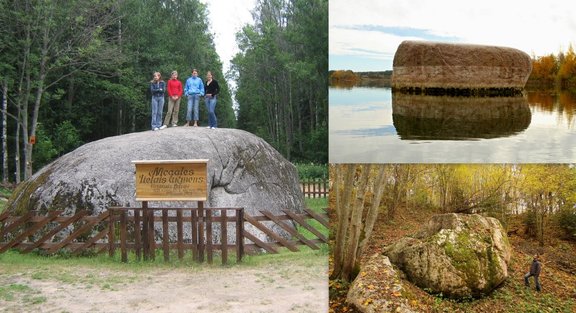
Vizla Great Stone
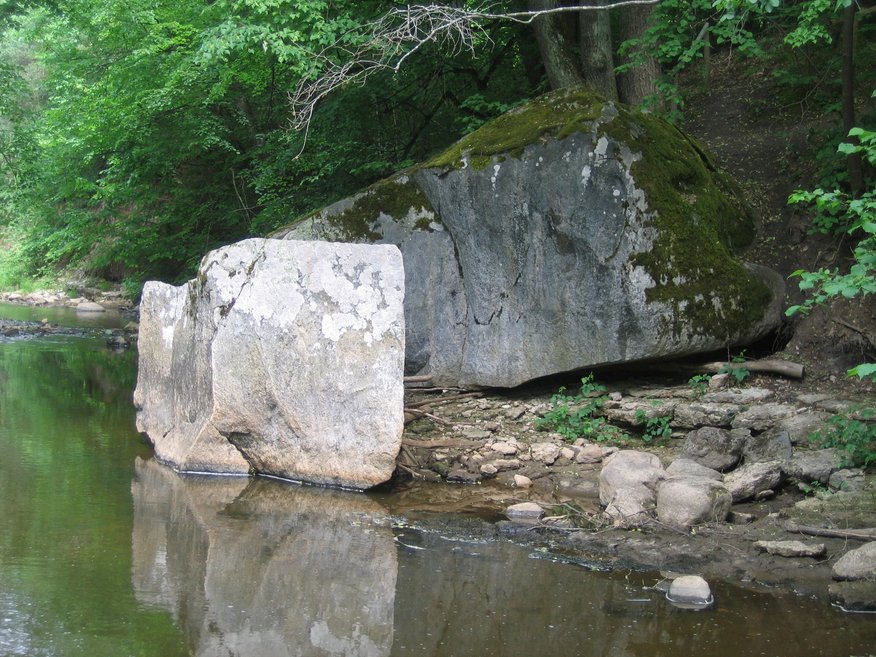
The Vizla Great Stone is located in Vireši parish, Ape county. You will find it in the Vizla River valley, near where it flows into the River Gauja. Due to its size, this great stone is considered the largest in Northeast Vidzeme—it measures 15 metres in circumference. The stone is 3.4 metres tall, six metres long and 3.7 metres wide. Its volume is around 35 cubic metres.
A smaller section of around 6 cubic metres has broken off on the river-facing side, so the rock is in two parts. It is also sometimes called the Big Vizla Rock, or named after the nearby house: the Žākli Great Stone. Meanwhile, it gained another of its names, Velnakmens (Devil’s Rock) from a legend which states that the Devil hid in the rock to escape the wrath of Pērkons (Thunder), a Latvian pagan god.
The rock is the main attraction of the Vizla Nature Trail. The trail, which is two kilometers one way, is located in the Ziemeļgauja protected landscape. It begins at an ancient arched dolomite bridge over the Vizla River and leads along the right-hand edge of the river.
Spuņņu dižakmens
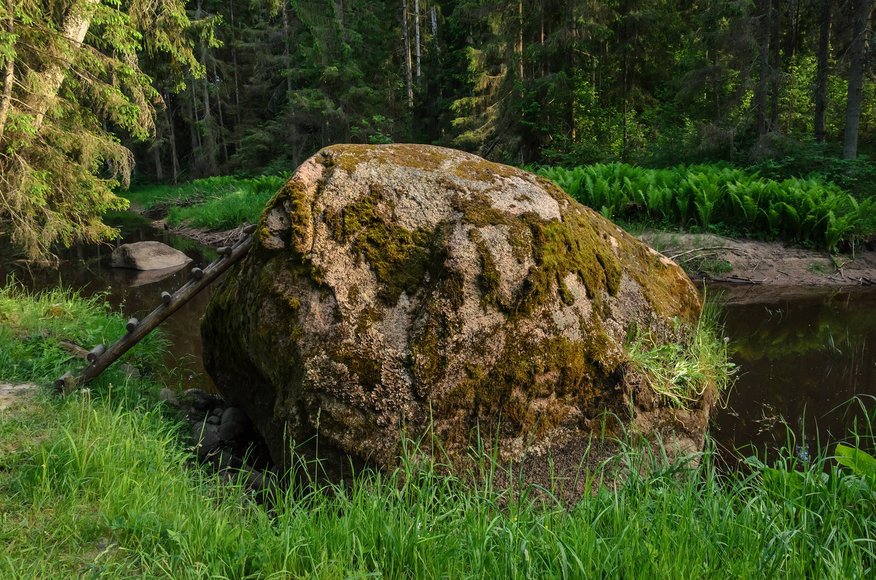
The Viesata River Meanders Nature and Discovery Trail contains a giant called the Spuņņu Great Stone.
The furthest point of the trail, in the fifth kilometer, is the location of the rock. It is classified as a great stone and is found by a tributary of the River Abava: the River Viesata. Scientists believe that the grey boulder was carried there by a glacier. The stone is around two metres tall and is as long as it is wide: 4.7 metres. The most agile are also able to climb it!
The trail is 11 kilometers long, but you can choose to only walk part of it because it includes shorter return paths. This makes it a great option for a family walk.
Dzelzāmurs Great Stone
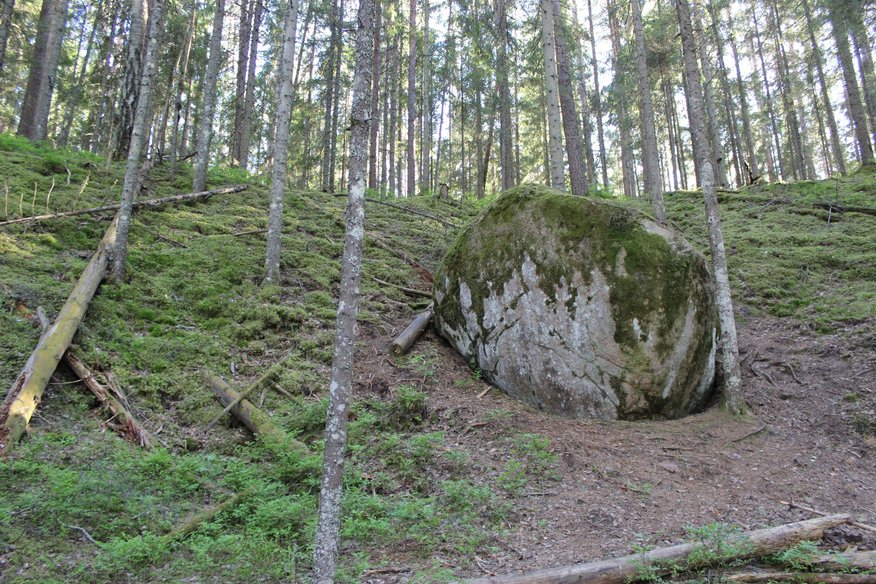
Karogu karjers (Flag Quarry), not far from Aloja and Staicele, is worth visiting at the weekend. Here, you will find both a picturesque nature trail and an impressive great stone!
If you follow the signs along the winding trail which leads along a forested ridge towards the Dzelzāmurs Great Stone, you will soon see a beautiful forest landscape with the small Kaugurupīte stream. Its winding banks are full of ferns, and you can see evidence of beavers. A short way later you will come across the stone itself, which seems to have come to a standstill halfway down the hill under the influence of unknown forces.
The aboveground portion of the stone is the height of a person and truly substantial. You will be able to climb on top for a photo. The information board states that the boulder is 3.4 metres long, 2.1 metres wide, 2.75 metres tall, and 9.2 metres in circumference.
Nīcgale Great Stone
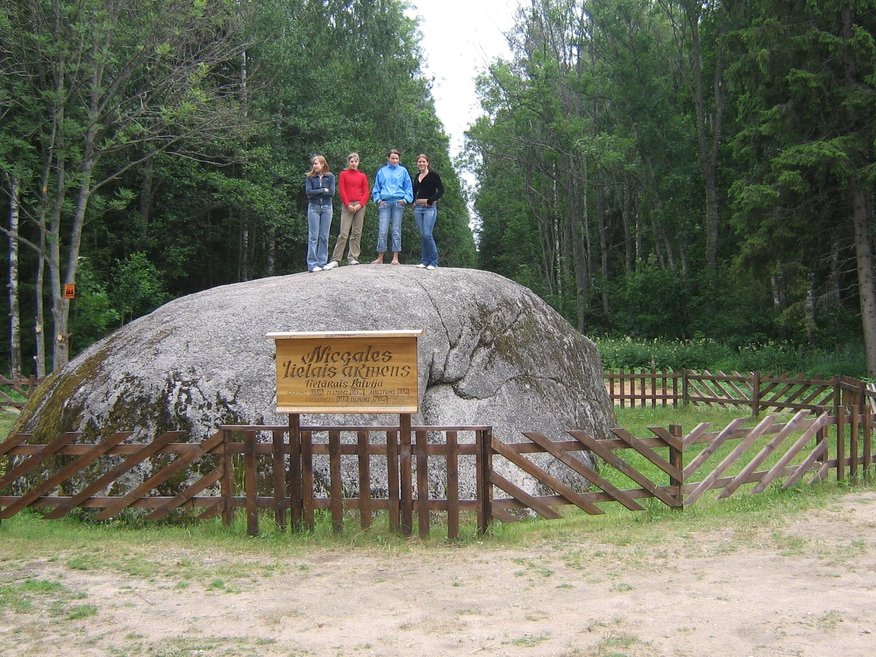
Anyone who visits Daugavpils county should definitely visit this grand old man—Latvia’s largest great stone—the Nīcgale Great (White) Stone, which is located deep in the forest, around six kilometers to the east of the Nīcgale train station.
The giant is 10.5 metres long and has a circumference of 31.1 metres. In 1938, three steps were carved into the side of the rock, so that now anyone can climb on the giant’s back and feel its might. The rock is the subject of many legends passed down from generation to generation. They all claim the source of the rock to be evil.
Once upon a time, the devil became jealous of the mighty River Daugava. He decided to put an end to it by filling up the river with earth. Up in the north, he filled a sieve with rocks and rushed to the Daugava. When he was almost at the river, he realised that all of the rocks had fallen through the sieve except for one enormous boulder. In anger, the devil threw it into the Nīcgale bog.
Scientists, on the other hand, believe that the several-million-year-old giant came to Latvia in a glacier from Finland. It was only discovered in the early 19th century, when Napoleon’s army was nearing Latgale. A new leisure space has been installed next to the stone, where you can have some refreshments, rest your legs and enjoy the quiet of the forest and the rustling of the trees.
Rogāļi Great Stone
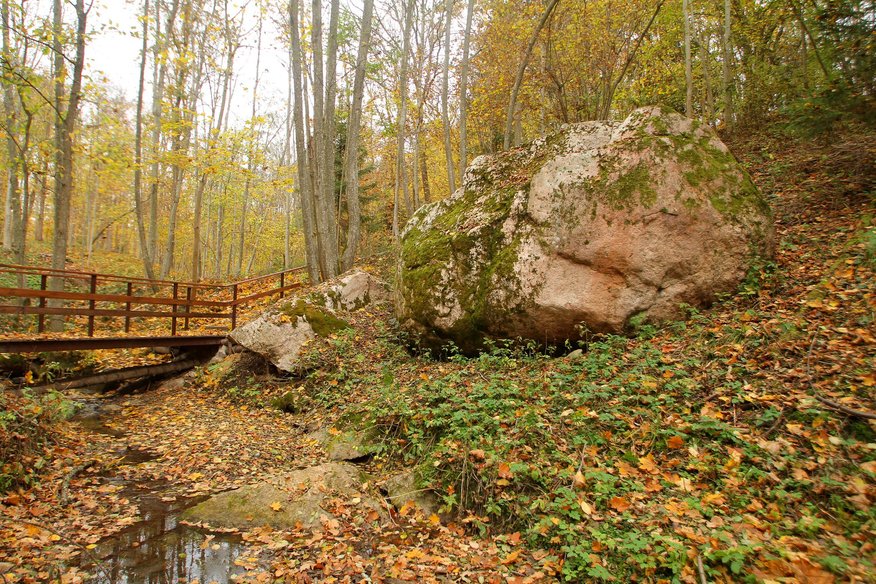
The Rogāļi Great Stone is a geological and geomorphological natural monument located in Kūkas parish near Jēkabpils. The rock originally came from the Karelian Isthmus.
Although the Rogāļi Great Stone isn’t in the top 10 of Latvia’s largest stones, it is impressive nonetheless. It is 6.5 metres long, 4.6 metres wide and 3.7 metres tall. It has a circumference of almost 19 metres, while its volume comes to 40 cubic metres. The stone isn’t smooth—it has a distinct surface.
The impressive natural monument can be found if you walk along the nature trail leading down the Rogāļi Ravine, near where the river flows into the River Daugava. The stone is conveniently located next to a litte bridge which allows you to see its greatness from all sides.
Runtiņš Spring Stone
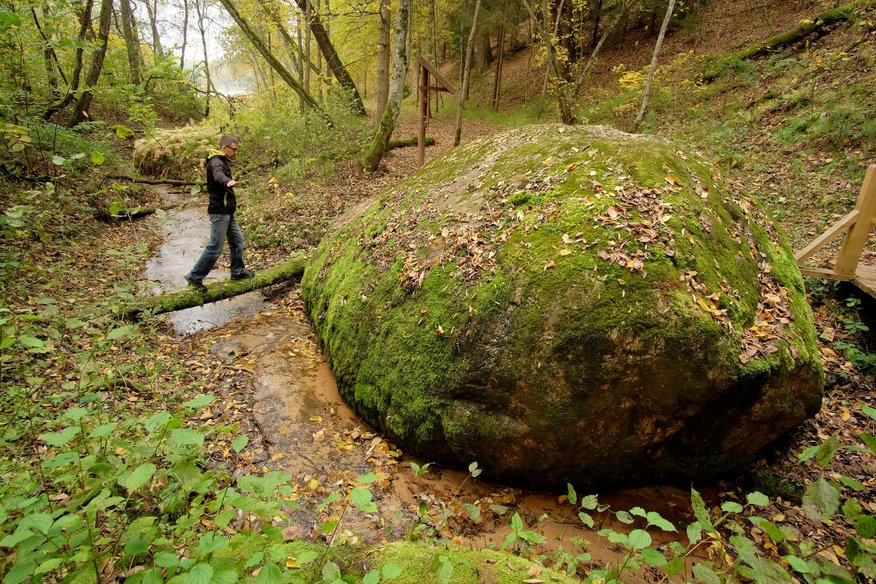
The Runtiņš Spring Stone, the Great Gauja Stone or simply the Great Stone: whatever people call it, they’re referring to this giant near Krimulda.
Its dimensions are very large. The stone is 2.5 metres tall, 5.3 metres long and reaches 3.7 metres in width, giving it a volume of 25 cubic metres. A powerful spring emerges from a sandstone outcrop next to the stone, and there is a pretty bridge nearby. Standing next to such a giant can truly make a person feel small.
You can get to the massive stone by going on a pretty walk along the 3.6 kilometer Kubesele Nature Trail, which starts and ends at the Krimulda Evangelical Lutheran Church.
The Devil’s Tailor
>
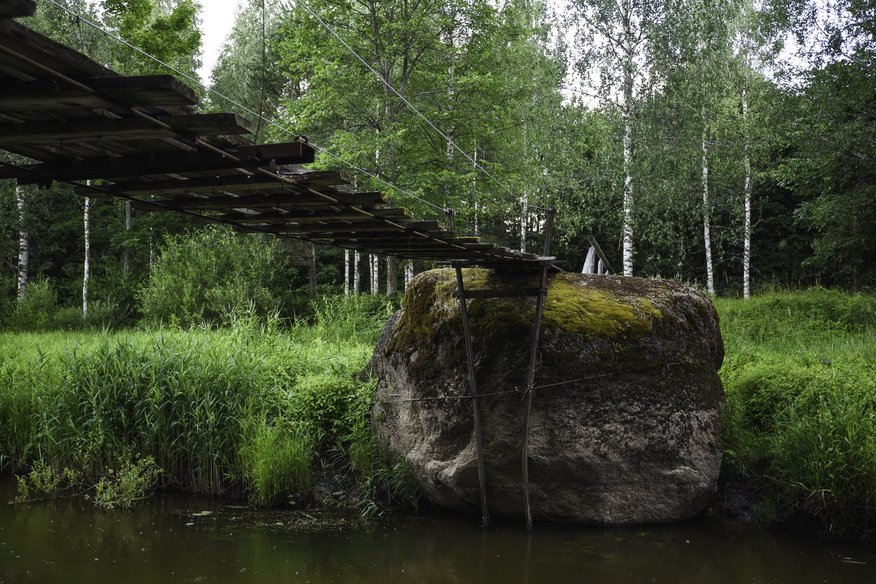
Velna Skroderis (the Devil’s Tailor) is the largest stone in the Vidzeme region of Latvia. Even more significantly, it is the third largest in Latvia, behind the Nīcgale Great Stone and the Radži Great Stone.
It is located in Madona county, Prauliena parish, where the stone has come in useful on the banks of the Kuja River. Locals have built a bridge over the river which is supported by the stone. It has a circumference of 20.2 metres, is 4.15 metres high, and has a volume of around 100 cubic metres. The great stone rests on other, smaller rocks, allowing the Devil’s Tailor to be viewed in its full majesty.
An ancient legend tells that the devil, having quarrelled with God, wanted to annoy him by filling in the Aiviekste River. As he stepped over the Kuja River, the devil’s trousers tore. He sat down on the great stone to mend the hole, and just as he had finished mending the hole, a cockerell started to crow on the opposite bank of the Kuja. The devil was forced to flee while the stone remained on the riverbank, and thanks to this it gained the name Devil’s Tailor.
Radži Great Stone
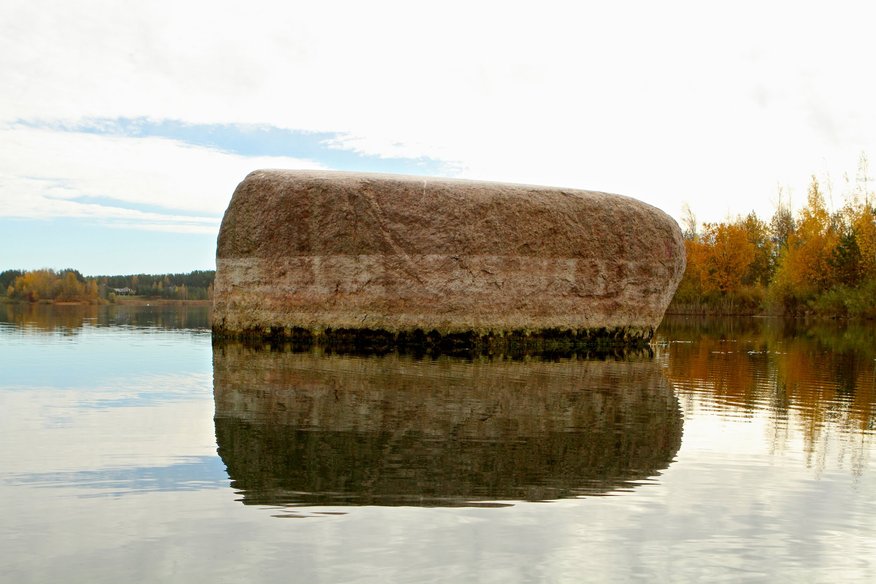
If you plan on visiting Jēkabpils at the weekend, you can’t drive past without stopping at the impressive Radži Great Stone. The stone is also called the Brodi Quarry Boulder. It is the second largest great stone in Latvia behind the Nīcgale Great Stone. It is located in Jēkabpils, in the Brodi Quarry Lake.
It has a circumference of 19 metres and a length of 6.1 metres. The great stone is six metres wide and reaches up to 4.6 metres in height. In earlier times, the stone was on an island, but now a portion of the stone is underwater, so slightly more than 3 metres of its height can be seen from the shore of the lake. The volume of the Radži Great Stone is more than 100 cubic metres.
Tilgaļi Giant Boulder
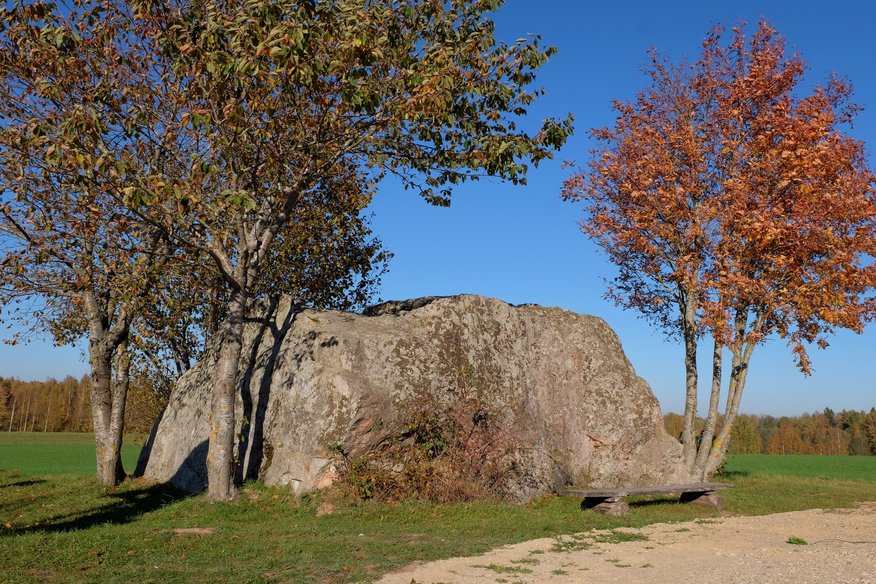
The Tilgaļi Giant Boulder, or Tilgaļi Great Stone, is sometimes also called the Krauji or Vandzene Stone. It is the largest great stone in Kurzeme, and the fourth largest in Latvia. The stone is in Talsi county, Vandzene parish.
The circumference of the stone is 26 metres. It is 7.35 metres long and seven metres wide. It reaches a height of 3.4 metres and has an above-ground volume of 80 cubic metres. The stone has suffered some destruction over time, so it appears irregular and angular.
Ābeļi Stone
>
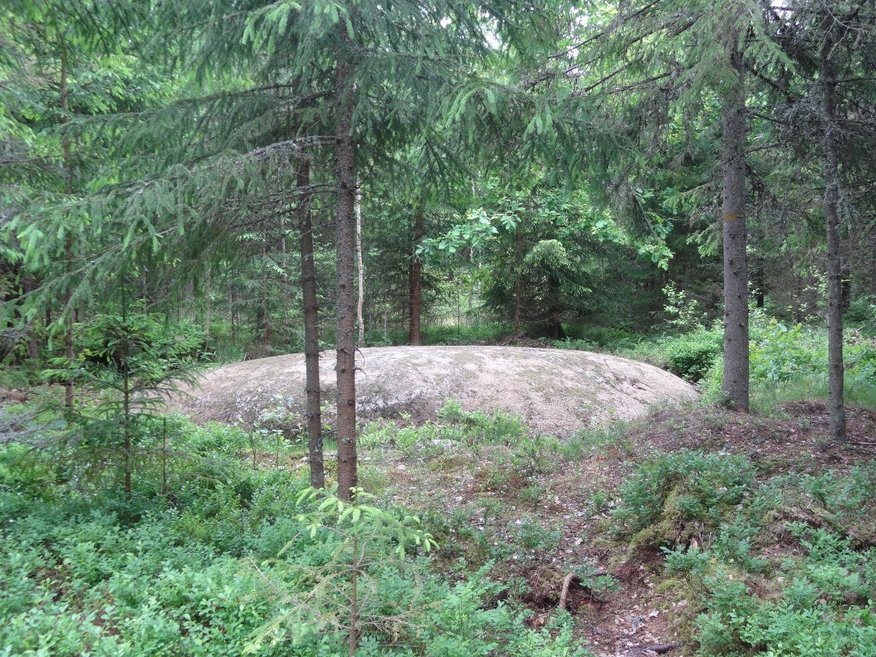
Surrounded by spruce and birch trees, a remarkable great stone can be found in Burtnieki county, Rencēni parish. It is most widely known as the Ābeļi Stone, but is also called the Mūrkrogs and Mežvidi Great Stone.
The great stone is located in Burtnieki county, Rencēni parish, not far from the Ābeļi houses — 100 metres south of the road to the Ābeļi houses. It is 8.6 metres long, 5.8 metres wide and 2.3 metres tall.
The stone is also popular as a geocaching spot.



